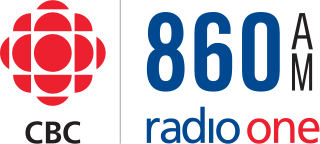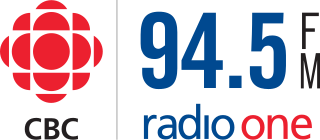Related Research Articles
CJOH-DT is a television station in Ottawa, Ontario, Canada, serving the National Capital Region as part of the CTV Television Network. It is owned and operated by network parent Bell Media alongside Pembroke-licensed CTV 2 outlet CHRO-TV. The two stations share studios with Bell's Ottawa radio properties at the Market Media Mall building on George Street in downtown Ottawa's ByWard Market; CJOH-DT's transmitter is located on the Ryan Tower at Camp Fortune in Chelsea, Quebec, north of Gatineau.
TVO, formerly known as TVOntario, is a publicly funded English-language educational television network and media organization serving the Canadian province of Ontario. It operates flagship station CICA-DT in Toronto, which also relays programming across portions of Ontario through eight rebroadcast stations. All pay television providers throughout Ontario are required to carry TVO on their basic tier, and programming can be streamed for free online within Canada.

CKNX-TV was a television station owned by CTVglobemedia which served mid-western Ontario, Canada. It was part of the A television system. The station's offices, studios, and transmission facilities were located at Carling Terrace corner John Street in Wingham. A bureau in Owen Sound closed down in late 2004.
CBLT-DT is a television station in Toronto, Ontario, Canada, serving as the flagship station of the English-language service of CBC Television. It is part of a twinstick with Ici Radio-Canada Télé outlet CBLFT-DT. The two stations share studios at the Canadian Broadcasting Centre on Front Street West in downtown Toronto, which is also shared with national cable news channel CBC News Network and houses the studios for most of the CBC's news and entertainment programs. CBLT-DT's transmitter is located atop the CN Tower.
CICI-TV is a television station in Sudbury, Ontario, Canada, part of the CTV Television Network. The station is owned and operated by network parent Bell Media, and has studios on Frood Road in Sudbury; its transmitter is located near Huron Street.
CITO-TV is a television station in Timmins, Ontario, Canada, part of the CTV Television Network. Owned and operated by network parent Bell Media, the station has studios on Pine Street North in Timmins, and its transmitter is located near Highway 101. It also operates rebroadcasters in Kapuskasing, Kirkland Lake, Hearst and Chapleau.
CKNY-DT is a television station in North Bay, Ontario, Canada, part of the CTV Television Network. Owned and operated by network parent Bell Media, the station maintains a transmitter adjacent to Ski Hill Road in Nipissing.

CHEX-DT is a television station in Peterborough, Ontario, Canada, part of the Global Television Network. Owned and operated by network parent Corus Entertainment, the station maintains studios on Monaghan Road in the southern portion of Peterborough, and its transmitter is located on Television Hill, just outside the city.
CBLFT-DT is an Ici Radio-Canada Télé station in Toronto, Ontario, Canada, which broadcasts programming to the province's Franco-Ontarian population. It is part of a twinstick with CBC Television flagship CBLT-DT. The two stations share studios at the Canadian Broadcasting Centre on Front Street West in downtown Toronto; CBLFT-DT's transmitter is located atop the CN Tower.
CBOFT-DT is an Ici Radio-Canada Télé station in Ottawa, Ontario, Canada, serving the National Capital Region. It is part of a twinstick with CBC Television station CBOT-DT. The two stations share studios at the CBC Ottawa Broadcast Centre on Queen Street in Downtown Ottawa, alongside the main corporate offices of the CBC; CBOFT-DT's transmitter is located on the Ryan Tower at Camp Fortune in Chelsea, Quebec, north of Gatineau.
CKNC-TV was a television station in Sudbury, Ontario, Canada. The station was in operation from 1971 to 2002 as a private affiliate of CBC Television, and then continued until 2012 as a network-owned rebroadcaster of the network's Toronto affiliate CBLT.
CBC Television is a Canadian English-language broadcast television network owned by the Canadian Broadcasting Corporation, the national public broadcaster. The network began operations on September 6, 1952, with its main studios at the Canadian Broadcasting Centre in Toronto. Its French-language counterpart is ICI Radio-Canada Télé.
CBLA-FM is a non-commercial radio station in Toronto, Ontario, Canada. Owned and operated by the Canadian Broadcasting Corporation, the station is the flagship station of the CBC Radio One network, broadcasting a mix of news and talk. In addition to the Toronto market, CBLA also reaches much of Central Ontario with a network of twelve rebroadcasters. The studios are in the Canadian Broadcasting Centre.
CBON-FM is a Canadian radio station. It broadcasts the Société Radio-Canada's Ici Radio-Canada Première network at 98.1 FM in Sudbury, Ontario. The station also serves much of Northern Ontario through a network of relay transmitters.
CJBN-TV, VHF analogue channel 13, was a Global-affiliated television station licensed to Kenora, Ontario, Canada. The station was owned by Shaw Communications under its cable systems unit, and was not part of the Shaw Media unit which was sold to Corus Entertainment in 2016. CJBN's studios were based alongside Shaw's local offices on 10th and Front Streets in Keewatin, and its transmitter was located near Norman Dam Road in Kenora. The station was carried on Shaw Cable channel 12, Bell Satellite TV channel 224 and Shaw Direct channel 320.

CBC North is the Canadian Broadcasting Corporation's radio and television service for the Northwest Territories, Nunavut, and Yukon of Northern Canada as well as Eeyou Istchee and Nunavik in the Nord-du-Québec region of Quebec.
The Ontario Parliament Network is a television channel in the Canadian province of Ontario, established in 1986 to broadcast the parliamentary proceedings of the Legislative Assembly of Ontario. It is available on all cable television providers in Ontario, as well as by webcast.

CHAK is a Canadian radio station, broadcasting at 860 AM in Inuvik, Northwest Territories. The station broadcasts the programming of the CBC Radio One network known as CBC North.
Digital terrestrial television in Canada is transmitted using the ATSC standard. Because Canada and the U.S. use the same standard and frequencies for channels, people near the Canada–United States border can watch digital television programming from television stations in either country where available. The ATSC standards are also used in Mexico, the Dominican Republic, Suriname, and South Korea.

CFWH-FM is a Canadian radio station broadcasting at 94.5 MHz FM in Whitehorse, Yukon. The station broadcasts the programming of the CBC Radio One network known as CBC North. Until its closure in 2012, CFWH's sister television station was CFWH-TV.
References
- 1 2 3 4 5 "The illegal TV network in northern Ontario that tried to go legit". CBC News, 26 February 2019.
- 1 2 3 4 5 "Hamlets in the North get flea-powered TV". The Globe and Mail , 6 January 1978.
- 1 2 3 4 5 6 Donaldson, Gordon (3 March 1979). "Space Age TV". The Canadian. pp. 3–4. Retrieved 27 July 2012.
- 1 2 3 4 5 6 7 8 9 10 11 Lilley, Wayne (March 1980). "King of the shoestring network". Financial Post Magazine. pp. 51–57. Retrieved 27 July 2012.
- ↑ "100 TV channels free for taking". The Globe and Mail , 21 March 1980.
- 1 2 "Transmitting equipment confiscated". Leader-Post. Regina. 4 February 1978. p. 31. Retrieved 26 July 2012.
- 1 2 "Ontario towns can keep two illegal TV stations". Montreal Gazette . 31 May 1977. p. 8. Retrieved 27 July 2012.
- ↑ "TV policy for remote areas will evolve from CRTC hearing". Montreal Gazette . 11 August 1978. p. 42. Retrieved 27 July 2012.
- ↑ de Jordy, Herve (8 August 1988). "Why can't we have school radio stations?". Toronto Star. p. B3. Archived from the original on 31 January 2013.
- ↑ The Canadian Press (25 July 1979). "Ontario stations remain on air". Edmonton Journal. p. E2. Retrieved 27 July 2012.
- 1 2 The Canadian Press (13 July 1978). "Prairie towns defying CRTC". Montreal Gazette . p. 46. Retrieved 27 July 2012.